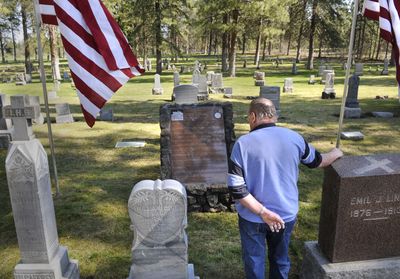Monument recognizes Titanic-Spokane link

This is one of those six-degrees-of-separation stories – complete with intriguing sidebars, about Spokane – the RMS Titanic and the thread that weaves them together. That thread is an Irish immigrant buried in Spokane.
And it is a story commemorated with a new monument at Fairmount Memorial Gardens, dedicated April 15 – 97 years to the day after the luxury liner sank after hitting an iceberg in the North Atlantic on her maiden voyage.
“I became obsessed with this story a couple of years ago,” said Duane Broyles, president of the Fairmount Memorial Association, “and with the help of a lot of people, we worked to create the monument in order to tell the story.”
It all begins with William Rice, who emigrated with his wife, Margaret, from Ireland. In 1902 he found work in Montreal as a shipping clerk for the Grand Trunk Railway, which was managed by Charles Melville Hays. The Rice family moved to Spokane in 1909 and Rice went to work as a machinist for Great Northern Railroad.
However, in 1910 at age 32, he died of injuries from an accident at the railyard in Hillyard, leaving behind his widow and five children.
Rice was buried at Fairmount. The man who prepared the gravesite was Fairmount laborer John Henry Chapman, who had come to Spokane from England.
With the settlement she received from the railroad, Margaret Rice purchased some property in Spokane and moved her husband’s remains from the $5 plot where he was first interred to a $50 plot with grand headstone, again with Chapman preparing the site. The second burial took place on April 15, 1910, exactly two years before the Titanic tragedy.
She then took her children back to Ireland for a long visit and booked third-class passage on the Titanic for her return trip to America.
Chapman went back to England to marry his childhood sweetheart, Sara Elizabeth “Lizzie” Lawry. They booked second-class passage aboard the Titanic for their honeymoon and return voyage to the United States.
The Grand Trunk Railway’s Charles Hays, who had attended a railway board meeting in England, and his wife, Clara, booked first-class passage aboard the Titanic as guests of White Star Line’s managing director J. Bruce Ismay for their trip home. They were accompanied by their daughter and son-in-law.
The Rice family, the Chapman newlyweds and Charles Hays did not know one another, nor did they know of their connection to Spokane through William Rice, Broyles said.
The Titanic struck an iceberg at 11:40 p.m. on April 14 about 400 miles off Newfoundland. A few hours later, at 2:20 a.m. April 15, the great ship disappeared beneath the surface of the Atlantic. Among the 1,517 people who died either on board or in the frigid water were Margaret Rice and her children, John and Lizzie Chapman, and Charles Hays.
Records show that Margaret’s body and that of her youngest son, Eugene Francis, 2 1/2, were recovered; the other children’s remains were lost forever. John Chapman’s body was recovered, but Lizzie’s was never found. Margaret Rice, her son and Chapman were buried in Halifax, Nova Scotia. Hays’ body was recovered and returned to Montreal for burial. Hays’ wife, daughter and son-in-law were among the survivors.
But that’s not the end of the story. Broyles said Chapman’s pocket watch was found on his body. Not being waterproof, it stopped when he went into the water at 1:45 a.m. The watch is now on display in the Titanic Honor and Glory Exhibit at Falmouth, County Cornwall, England.
The story of John and Lizzie Chapman was the basis for the newlywed couple portrayed in the 1958 film about the Titanic, “A Night to Remember.”
There is now a plaque at Cobh, Ireland, where the Irish passengers boarded a ferry to take them out to the Titanic (it was known as Queenstown then). Pictured on the plaque are a woman and five children. Broyles said the image is modeled after the Rice family.
The Titanic monument at Fairmount Memorial Park, located just behind William Rice’s heart-shaped headstone, is made of native basalt taken from the hillside at Greenwood Memorial Park in Spokane, with the front side covered with a large piece of granite on which the story is told. Also depicted there is John Chapman’s pocket watch and a copy of the Cobh image of Margaret Rice and children. All of the stone work and engraving/etching was done on site by Fairmount staff.
“This is the 10th monument we’ve put up in cooperation with the Spokane Police Department History Book Committee and the Spokane Law Enforcement Museum,” Broyles said. “There are so many stories to tell, and we want to tell as many as we can.”
Incidentally, but unrelated to this story, Broyles discovered there were two others with Spokane connections aboard the Titanic, though not traveling together – Johan Svensson Lundahl, a bartender who was returning to his home at 421 Carlisle Ave. in Spokane after a visit to Sweden, and Agda Thorilda Viktoria Lindahl, a New York resident who had been visiting family in Stockholm.
According to White Star passenger records, she was going to the home of Alfred Johnson at 421 Carlisle Ave. in Spokane. Broyles said the connection between Lundahl, Lindahl and Johnson is unknown.
That might be a good Titanic-Spokane mystery to investigate on another day.